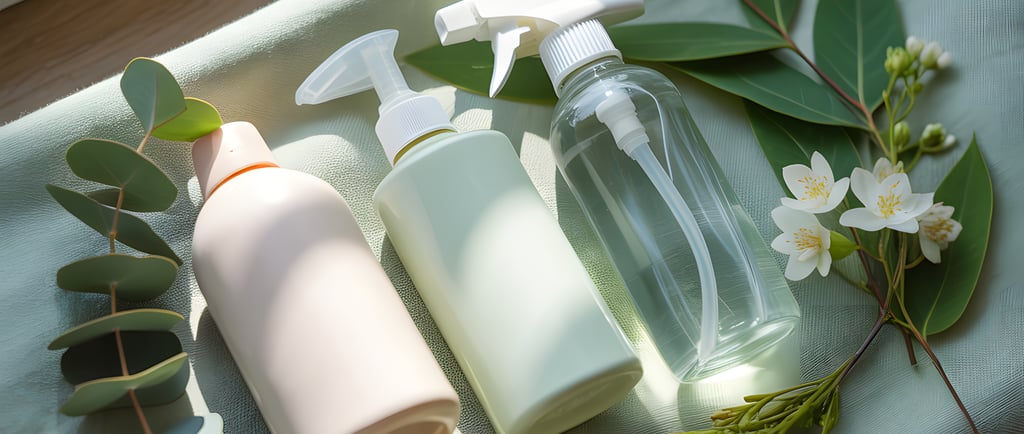The Hidden Truth About Your Daily Choices
Understanding the true impact of synthetic ingredients on health and discovering pure alternatives
MODERN LIVING
Vin
9/11/20254 min read



Every morning, millions of families worldwide start their day with a routine that involves dozens of products they trust completely. The breakfast cereal that promises nutritional benefits. The toothpaste marketed as "gentle and safe." The processed snacks packed in school lunches.
Yet beneath these familiar brands lies a complex web of synthetic ingredients that deserve our careful attention and understanding. Today's households contain hundreds of different chemical products. Walk through your home right now. From the laundry room to the kitchen, from the bathroom to the bedroom closet. Each space holds multiple bottles, sprays, and containers that have become essential parts of our daily routines. Consider your current shopping list. Perhaps it includes that all-purpose cleaner you've used for years, the dish soap that cuts through grease effortlessly, or the carpet shampoo that refreshes your living room. These products work. They deliver the results promised on their colorful packaging.
Understanding their complete composition reveals a darker truth.
The Modern Food Revolution: Beyond Natural Ingredients
Today's food industry has transformed dramatically from the simple, farm-to-table approach our grandparents knew. Walk through any supermarket and examine the ingredient lists, you'll discover names that sound more like chemistry experiments than food components. Ultra-processed foods now comprise over 60% of the average family's daily caloric intake.
Consider what occupies your current pantry: breakfast cereals containing BHT (butylated hydroxytoluene), frozen meals with sodium benzoate, colorful candies featuring Yellow #5 and Red Dye #3, diet sodas sweetened with aspartame. These ingredients serve specific industrial purposes like extending shelf life, creating appealing colors, enhancing flavors, and reducing production costs (perhaps the most pinning reason).
Research from leading nutritional institutes reveals concerning patterns about common food additives. Sodium benzoate, found in carbonated beverages and salad dressings, can combine with vitamin C to form benzene, that is a compound linked to cellular damage. Studies involving 173,000 adults over 13 years demonstrate that higher consumption of ultra-processed foods correlates with increased risks of cardiovascular disease, diabetes, and certain cancers. Artificial sweeteners like aspartame, marketed as healthier alternatives to sugar, demonstrate effects that extend beyond simple calorie reduction. Recent studies link high consumption of non-caloric sweeteners to cardiovascular complications and mood disorders in adults, while childhood exposure shows associations with obesity patterns.
The Personal Care Paradox: It Starts With Your Toothpaste!


Perhaps the most surprising revelations come from products we use twice daily without question: our toothpaste. This essential hygiene product contains ingredients that would surprise most consumers who examine labels carefully. Every tube of conventional toothpaste contains fluoride compounds designed to strengthen tooth enamel. While effective for cavity prevention, fluoride presents complex considerations. Chronic exposure can lead to dental fluorosis i.e. permanent discoloration of teeth, particularly in children who swallow toothpaste during brushing. The International Association of Oral Medicine and Toxicology documents additional concerns, including potential links to thyroid dysfunction, cardiovascular complications, and neurological effects when consumed in higher quantities over time.
Beyond fluoride, conventional toothpastes contain triclosan (an antimicrobial pesticide), sodium lauryl sulfate (SLS) which can irritate mouth tissues and cause canker sores, and titanium dioxide which is classified by environmental groups as a possible carcinogen. These ingredients work effectively for their intended purposes: triclosan reduces bacterial growth, SLS creates the foaming action consumers expect, and titanium dioxide provides the bright white appearance. Yet families seeking gentler alternatives discover that effective oral care can be achieved through different approaches.
From Shelf to Home: Understanding What Must Not Enter
The ability to decode ingredient lists becomes essential for making informed choices. Manufacturers must list ingredients in descending order by weight, revealing the true composition of products. When examining food labels, watch for:
🧪 Sodium benzoate or potassium benzoate (preservatives that can form harmful compounds)
🚸 Artificial colors (Yellow #5, Blue #1, Red Dye #3) linked to behavioral changes in children
🥤 High fructose corn syrup associated with metabolic disruption
🍔 Trans fats (partially hydrogenated oils) linked to cardiovascular disease
🥓 Sodium nitrite in processed meats, which can form nitrosamines when heated
Every product choice you make today influences your family's health trajectory. The synthetic additives in processed foods accumulate over time. The harsh chemicals in conventional personal care products interact with your skin daily. These seemingly small exposures create cumulative effects that impact long-term wellness.
Your Family's Wellness Investment
Natural alternatives exist for virtually every synthetic product in your home. Herbal tinctures provide concentrated plant nutrition. Functional foods deliver active compounds that support optimal health. Natural cosmetics nourish your skin without synthetic chemicals.
The transition requires initial research and adjustment, but families who make these changes consistently report improved energy, better sleep, clearer skin, enhanced mood, and greater overall wellness.
Every ingredient matters. Every choice counts. Your family's future wellness begins with the decisions you make right now.
The cosmetics industry faces similar challenges with synthetic ingredients. Conventional products contain parabens (hormone disruptors), sulfates (skin irritants), and synthetic fragrances (potential allergens). That diet soda marketed as a healthier choice delivers a complex cocktail of artificial sweeteners, preservatives, and synthetic additives directly into your child's developing system. Artificial sweeteners like aspartame break down into compounds including aspartic acid and phenylalanine, while storage in clear bottles under light exposure creates previously unknown phenolic derivatives with potentially harmful effects.
Those brightly colored snacks that delight children contain synthetic dyes linked to behavioral disorders, learning difficulties, and potential carcinogenic effects. Artificial colors, particularly Yellow #5, Red #40, and Blue #1—cause hyperactivity, decreased attention span, and increased impulsivity in children with and without ADHD. Ultra-processed snacks now comprise over 40% of children's daily caloric intake, delivering combinations of preservatives, artificial flavors, and texture modifiers that create addiction-like responses in developing brains. The synthetic additives in popular children's snacks like sodium benzoate, artificial colors, and flavor enhancers, work together to create hyperpalatable foods that override natural satiety signals. This leads children to overconsume while missing essential nutrients needed for proper growth. Thankfully, the European regulations now require warning labels on foods containing certain artificial colors, acknowledging their potential to affect children's behavior and attention, however such protections don't exist in other markets.
Listen to the article

I'm waking up to ash and dust
I wipe my brow and I sweat my rust
I'm breathing in the chemicals
- Radioactive, Imagine Dragons


